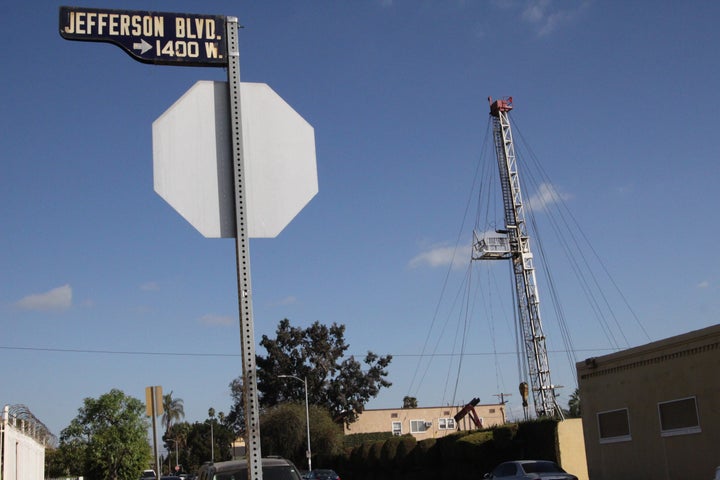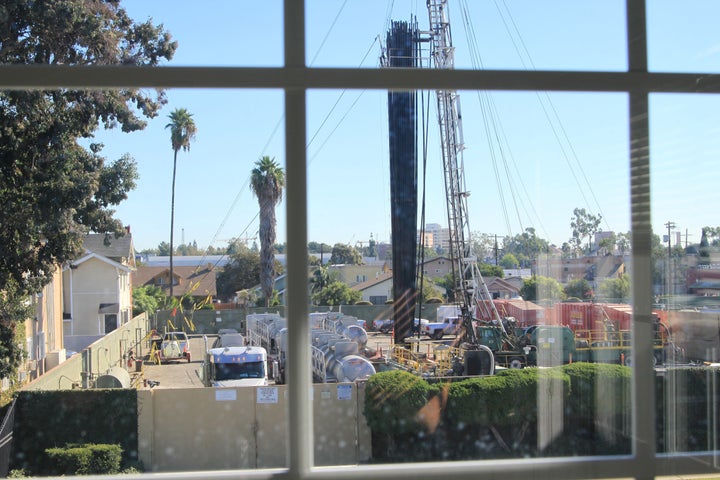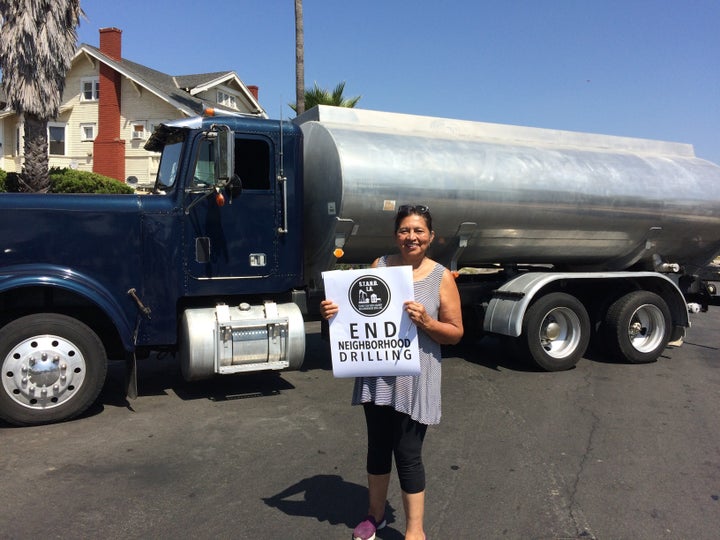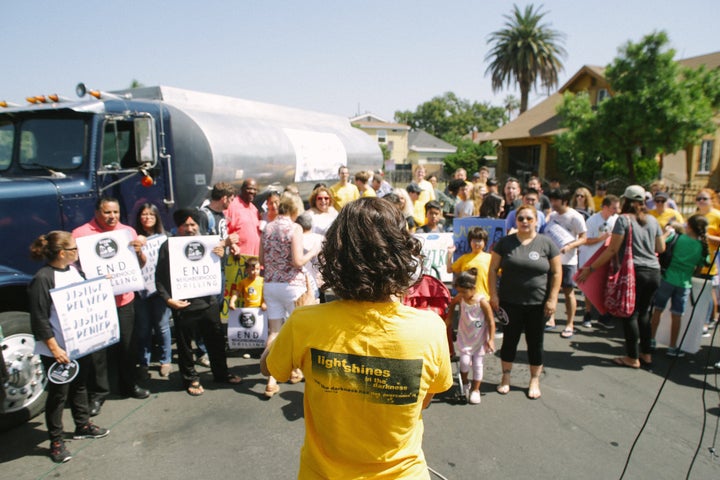Over more than 30 years living on Budlong Avenue, Lillian Marenco became used to the smell of rotten eggs and diesel fuel that seeped through her closed bedroom and kitchen windows day and night. Screeching and clanking sounds of metal on metal went on long into the evening.
Just three doors down from her home, oil rigs worked nonstop, penetrating deep into the earth and stone without interruption, pumping from 36 wells clustered on two acres of land. Slick drops of oil accumulated on front porches and cars on the densely populated streets of her South Los Angeles neighborhood.
In a city pockmarked with oil facilities – LA has about 1,000 active wells – the Jefferson Boulevard site is the closest to people’s homes. In some places, you can put one hand on a bedroom window and the other on the facility wall. Big Oil is just a fact of life here, Marenco said.
The site is now set to be closed, thanks to local residents and activists who fought against the toxic impact of the quest for oil. The neighborhood’s struggle not only marked a life-changing victory for the health and well-being of the residents of South Los Angeles — it also exposed the racial and economic discrimination that allowed pumping to continue for over five decades without being held to adequate health and safety standards. The win sets a hopeful precedent for other communities across the city trying to stand up to Big Oil in their backyards.
Marenco and her husband bought their home around the corner from the entrance to the Jefferson Boulevard drill site in 1987. Her youngest son grew up with frequent nosebleeds. Her husband passed away last year. Marenco said she’s unsure if the chemicals in the air played a part in his death. He had been diagnosed with mesothelioma, an aggressive type of cancer that affects the tissue around organs.

The sounds, smells and oil drops that came from the drill site were nuisances, but, for a long time, residents living near the property figured it was the way things were in that part of LA. They didn’t worry about their effects. They were more focused on getting by than filing complaints.
“We didn’t think about where [the odor] came from,” Marenco said. “You’re so worried about working, about paying bills and doing other things, you don’t think about it until someone tells you.”
That changed in 2013, when the owner of the oil drilling site, then Freeport-McMoRan Oil & Gas (whose California assets were later acquired by Sentinel Peak Resources), announced a plan to add one well to the site and redrill two older wells. A ripple of anger and concern rose throughout the community.
Marenco, along with around 100 of her neighbors, became involved with Redeemer Community Partnership, a local organization made up of community faith leaders and activists that rallied residents against the expansion plans.
Though Freeport shelved its expansion plans in 2015, citing a “steep decline in commodity prices,” the community was not going to let the company off the hook.
“In a city pockmarked with oil facilities, the Jefferson Boulevard site is the closest to people’s homes. In some places, you can put one hand on a bedroom window and the other on the facility wall.”
Together, with the help of the nonprofit environmental law organization EarthJustice, residents and activists submitted a 355-page petition to the city of Los Angeles in 2016, laying out why the planning department had to step up to protect the residents around the Jefferson drill site. It called on the city to enforce its health and safety codes and pressure Sentinel Peak, the new owner, to install safety upgrades at the site.
“For far too long, the community near the Jefferson Drill Site has been subjected to ongoing nuisance conditions caused by this facility,” said the petition. “These violations threaten the community’s health and safety, as well as disrupt the peaceful enjoyment of their homes.”
The petition documented studies on the chemicals produced in oil extraction and reports of toxic emissions from the Jefferson Boulevard drill site. Among the chemicals discovered was hydrogen sulfide, a gas that smells like rotten eggs and can cause respiratory problems.

It also cited an inspection of the site by the South Coast Air Quality Management District that found “that equipment at the site was releasing air contaminants that could be smelled outside of the facility.” Two notices of violation reported that among the chemicals present was benzene, a cancer-causing agent.
Through data, permits and research, the petition demonstrated that while in other — richer, whiter — parts of the city, such emissions were monitored and controlled, the company was operating virtually unchecked at the Jefferson site.
“On the Westside, they had enclosures, electric rigs,” said Angela Johnson Meszaros, managing attorney for EarthJustice and one of the authors of the petition. “We framed all this by saying South LA deserves the same kinds of protections that predominantly white communities already had.”
In Los Angeles’ tonier Westside neighborhoods, where 69% of the population is white and the median income is $78,000, the city pushed for safety regulations such as enclosures and air monitors at two other oil sites, the petition showed. Those who live near the Jefferson drill site did not have the same protections. There, residents — of whom 41% are Latino and 11% are black — earn a median income of $23,000, according to 2017 census data.
About one-third of Los Angeles County residents live within a mile of a drilling rig, according to a 2017 study by student researchers from the University of California, Los Angeles. Minorities are overrepresented in this population: According to the study, 44% of African Americans, 38% of Asians and 37% of Latinos live next to oil drilling sites, compared with 31% of whites. Other research revealed that a disproportionate number of low-income people of color lived next to oil drilling sites that offered no health or safety protections to residents or workers.
“It’s environmental racism,” said Richard Parks, a South Los Angeles resident and president of Redeemer Community Partnership, the organization that led the charge to hold the owners of the Jefferson site accountable.
“We framed all this by saying South LA deserves the same kinds of protections that predominantly white communities already had.”
- Angela Johnson Meszaros, managing attorney for EarthJustice
The petition worked. In the fall of 2017, the city slapped strict operating requirements on Sentinel Peak, including the construction of a 45-foot-tall enclosure to reduce odors, noise and bright lights.
Sentinel Peak appealed, but the South Los Angeles Area Planning Commission upheld the conditions. So the company took the matter to court, arguing that the demands were “unduly oppressive,” and then, last summer, decided to abandon operations at the site entirely.
Sentinel Peak would not return several requests for comment. But according to city documents released from a November 2018 public hearing, a company representative said the decision to stop operations made more economic sense than implementing all the additional regulatory conditions mandated by the city.
“It is not our intention to sidestep the regulatory oversight or ignore any environmental obligations,” Amanda Parsons, a Sentinel Peak Resources representative, said in public testimony.
Oil is still being pumped from the Jefferson drill site wells as the company moves to remediate the property. (It has three years to clean up the site, according to an agreement with the city.) It’s unclear how the property will be used once it is cleaned, but residents hope it becomes a park or much-needed affordable housing.
Members of STAND (Stand Together Against Neighborhood Drilling) LA and Redeemer Community Partnership hope their work will push regulators to hold oil companies across the state accountable for their industry’s effects on residents. But those efforts face considerable challenges.

California may have some of the most stringent oil production regulations in the nation, but none of the regulatory agencies seem to communicate, said Damon Nagami, senior attorney and director of Natural Resources Defense Council’s Southern California Ecosystems Project.
“There’s a confusing morass of rules, depending on where you live,” Nagami said. “That’s unfortunate. No one should be facing health impacts because they live too close to an oil well.”
He’s advocating for broader policy changes, such as buffer zones on existing and new sites.
Pressured by a growing public outcry about the dangers posed by oil and natural gas wells, Los Angeles Mayor Eric Garcetti appointed Uduak-Joe Ntuk as the petroleum administrator for the city in 2016 to oversee oil and gas operations. It was a position that had been vacant since the 1980s, the mayor’s office said in published reports.
“Mayor Garcetti has made it clear that the City of L.A. must prioritize the closure of wells that threaten the health and well-being of our families — especially in low-income communities that have borne the brunt of health risks caused by hazardous oil drilling sites,” Ntuk said in a statement to HuffPost. “The closure of the Jefferson Drill Site is the latest step in our work to put communities first, keep the air clean, and move our city closer to a fossil fuel-free future.”
“No one should be facing health impacts because they live too close to an oil well.”
- Damon Nagami, Natural Resources Defense Council
The city says it’s evaluating the feasibility of a proposal by STAND-LA to force oil companies to phase out oil drilling and other “sensitive land uses” within 2,500 feet of homes, hospitals and schools.
Democratic state Assemblyman Al Muratsuchi adopted STAND-LA’s 2,500-foot buffer proposal in a state bill he introduced earlier this year.
Muratsuchi’s district includes Warner Energy & Power’s oil drilling site in Wilmington, a community in Los Angeles’ harbor area about 20 miles south of the Jefferson drill site. The community is predominantly Latino and the drill site there has 90 wells, according to STAND-LA, making it one of the largest oil fields in the nation.
His bill, which has support from STAND-LA, was recently tabled, but could be up for consideration in the next legislative session.
Not all state officials are friendly to strengthening controls. A July 2019 report shows how much clout Big Oil holds in the state. Released by the groups Consumer Watchdog and the FracTracker Alliance, the report noted that eight members of DOGGR, a California agency that manages the state’s oil and gas well approval and inspections process, hold stock in the companies their agency is supposed to regulate. In response, Gov. Gavin Newsom (D) fired the agency’s top supervisor.
Naturally, the oil industry has pushed back against increased regulation. Rock Zierman, chief executive officer for the California Independent Petroleum Association, said closing oil drilling sites not only costs jobs, but communities lose tax revenue generated by the industry.

“For the men and women who operated the Jefferson drill site, this is personal,” Zierman said in a statement. “But it’s difficult to explain why their jobs were outsourced to other nations, who do not have our same environmental protections, because we have to meet our state’s demand through more imported oil.”
Meszaros said the goal was not to close the Jefferson site or see workers lose jobs. She said the conditions the city issued would have protected workers, too.
“We are about workers,” she said of EarthJustice. “None of us are living a life where we don’t need to work, so it’s important that people have jobs, and good jobs.”
Corissa Pacillas Smith, a freelance artist who lives right across the street from the Jefferson oil field with her husband Nathan and newborn son, is looking forward to quieter days and nights.
Pacillas Smith can see the site and equipment from her second-floor living room window. Trucks still rumble in and out of the property.
The story of how the community came together to shut down the drill site serves as a reminder that sometimes “the little guy” can win, Pacillas-Smith said.
“Not just standing up to Big Oil,” she said, “but standing up to the ways in which these companies have sidestepped regulations or used their power and status to take advantage of these communities.”
For more content and to be part of the “This New World” community, follow our Facebook page.
HuffPost’s “This New World” series is funded by Partners for a New Economy and the Kendeda Fund. All content is editorially independent, with no influence or input from the foundations. If you have an idea or tip for the editorial series, send an email to thisnewworld@huffpost.com.
